2025
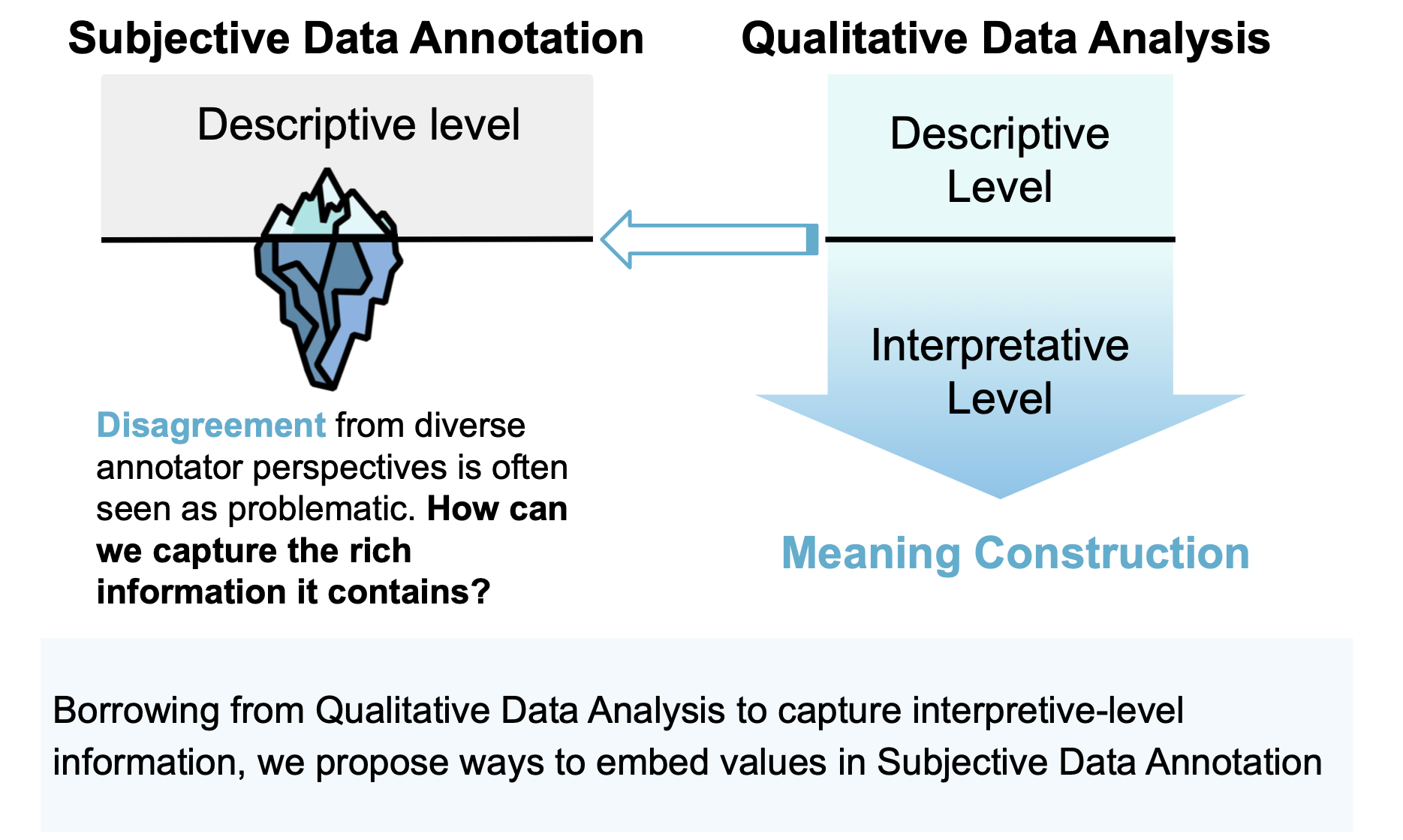
From Noise to Nuance: Enriching Subjective Data Annotation through Qualitative Analysis
Ruyuan Wan, Haonan Wang, Ting-Hao ‘Kenneth’ Huang, Jie Gao# (# advising author)
The 4th HCI+NLP Workshop at EMNLP2025
Subjective data annotation (SDA) plays an important role in many NLP tasks, including sentiment analysis, toxicity detection, and bias identification. Conventional SDA often treats annotator disagreement as noise, overlooking its potential to reveal deeper insights. In contrast, qualitative data analysis (QDA) explicitly engages with diverse positionalities and treats disagreement as a meaningful source of knowledge. In this position paper, we argue that human annotators are a key source of valuable interpretive insights into subjective data beyond surface-level descriptions. Through a comparative analysis of SDA and QDA methodologies, we examine similarities and differences in task nature (e.g., human's role, analysis content, cost, and completion conditions) and practice (annotation schema, annotation workflow, annotator selection, and evaluation). Based on this comparison, we propose five practical recommendations for enabling SDA to capture richer insights. We demonstrate these recommendations in a reinforcement learning from human feedback (RLHF) case study and envision that our interdisciplinary perspective will offer new directions for the field.
From Noise to Nuance: Enriching Subjective Data Annotation through Qualitative Analysis
Ruyuan Wan, Haonan Wang, Ting-Hao ‘Kenneth’ Huang, Jie Gao# (# advising author)
The 4th HCI+NLP Workshop at EMNLP2025
Subjective data annotation (SDA) plays an important role in many NLP tasks, including sentiment analysis, toxicity detection, and bias identification. Conventional SDA often treats annotator disagreement as noise, overlooking its potential to reveal deeper insights. In contrast, qualitative data analysis (QDA) explicitly engages with diverse positionalities and treats disagreement as a meaningful source of knowledge. In this position paper, we argue that human annotators are a key source of valuable interpretive insights into subjective data beyond surface-level descriptions. Through a comparative analysis of SDA and QDA methodologies, we examine similarities and differences in task nature (e.g., human's role, analysis content, cost, and completion conditions) and practice (annotation schema, annotation workflow, annotator selection, and evaluation). Based on this comparison, we propose five practical recommendations for enabling SDA to capture richer insights. We demonstrate these recommendations in a reinforcement learning from human feedback (RLHF) case study and envision that our interdisciplinary perspective will offer new directions for the field.

Understanding Codebase like a Professional! Human–AI Collaboration for Code Comprehension
Jie Gao, Yue Xue, Xiaofei Xie, Junming Cao, SoeMin THANT, Erika Lee, Bowen Xu
2025
Understanding an unfamiliar codebase is an essential task for developers in various scenarios, such as during the onboarding process. Especially when the codebase is large and time is limited, achieving a decent level of comprehension remains challenging for both experienced and novice developers, even with the assistance of large language models (LLMs). Existing studies have shown that LLMs often fail to support users in understanding code structures or to provide user-centered, adaptive, and dynamic assistance in real-world settings. To address this, we propose learning from the perspective of a unique role, code auditors, whose work often requires them to quickly familiarize themselves with new code projects on weekly or even daily basis. To achieve this, we recruited and interviewed 8 code auditing practitioners to understand how they master codebase understanding. We identified several design opportunities for an LLM-based codebase understanding system: supporting cognitive alignment through automated codebase information extraction, decomposition, and representation, as well as reducing manual effort and conversational distraction through interaction design. To validate these four design opportunities, we designed a system prototype, CodeMap, that provides dynamic information extraction and representation aligned with the human cognitive flow and enables interactive switching among hierarchical codebase visualizations. To evaluate the usefulness of our system, we conducted a user study with nine experienced developers and six novice developers. Our results demonstrate that CodeMap significantly improved users’ perceived intuitiveness, ease of use, and usefulness in supporting code comprehension, while reducing their reliance on reading and interpreting LLM responses by 79% and increasing map usage time by 90% compared with the static visualization analysis tool. It also enhances novice developers’ perceived understanding and reduces their unpurposeful exploration. The insights derived from our interviews and the design of CodeMap can inspire future LLM-based research on code comprehension, such as onboarding support systems.
Understanding Codebase like a Professional! Human–AI Collaboration for Code Comprehension
Jie Gao, Yue Xue, Xiaofei Xie, Junming Cao, SoeMin THANT, Erika Lee, Bowen Xu
2025
Understanding an unfamiliar codebase is an essential task for developers in various scenarios, such as during the onboarding process. Especially when the codebase is large and time is limited, achieving a decent level of comprehension remains challenging for both experienced and novice developers, even with the assistance of large language models (LLMs). Existing studies have shown that LLMs often fail to support users in understanding code structures or to provide user-centered, adaptive, and dynamic assistance in real-world settings. To address this, we propose learning from the perspective of a unique role, code auditors, whose work often requires them to quickly familiarize themselves with new code projects on weekly or even daily basis. To achieve this, we recruited and interviewed 8 code auditing practitioners to understand how they master codebase understanding. We identified several design opportunities for an LLM-based codebase understanding system: supporting cognitive alignment through automated codebase information extraction, decomposition, and representation, as well as reducing manual effort and conversational distraction through interaction design. To validate these four design opportunities, we designed a system prototype, CodeMap, that provides dynamic information extraction and representation aligned with the human cognitive flow and enables interactive switching among hierarchical codebase visualizations. To evaluate the usefulness of our system, we conducted a user study with nine experienced developers and six novice developers. Our results demonstrate that CodeMap significantly improved users’ perceived intuitiveness, ease of use, and usefulness in supporting code comprehension, while reducing their reliance on reading and interpreting LLM responses by 79% and increasing map usage time by 90% compared with the static visualization analysis tool. It also enhances novice developers’ perceived understanding and reduces their unpurposeful exploration. The insights derived from our interviews and the design of CodeMap can inspire future LLM-based research on code comprehension, such as onboarding support systems.
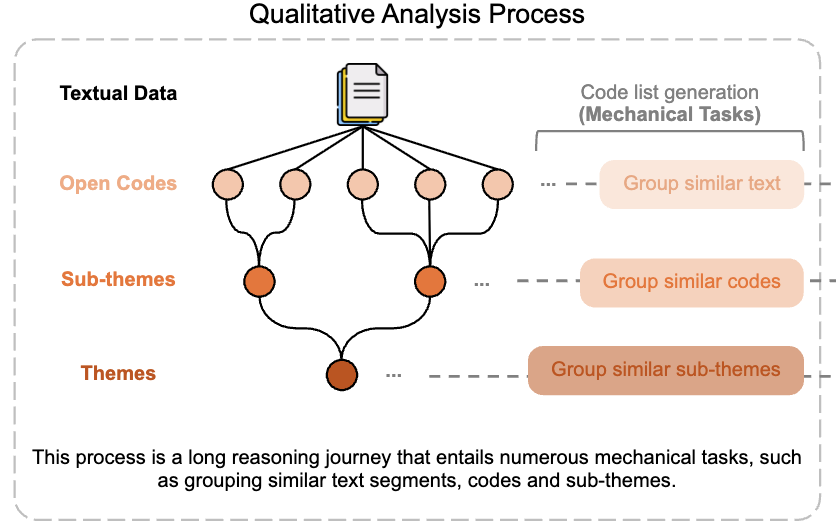
MindCoder: Automated and Controllable Reasoning Chain in Qualitative Analysis
Jie Gao, Zhiyao Shu, Shun Yi Yeo, Alok Prakash, Chien-Ming Huang, Mark Dredze, Ziang Xiao
2025
Qualitative data analysis (QDA) emphasizes trustworthiness, requiring sustained human engagement and reflexivity. Recently, large language models (LLMs) have been applied in QDA to improve efficiency. However, their use raises concerns about unvalidated automation and displaced sensemaking, which can undermine trustworthiness. To address these issues, we employed two strategies: transparency and human involvement. Through a literature review and formative interviews, we identified six design requirements for transparent automation and meaningful human involvement. Guided by these requirements, we developed MindCoder, an LLM-powered workflow that delegates mechanical tasks, such as grouping and validation, to the system, while enabling humans to conduct meaningful interpretation. MindCoder also maintains comprehensive logs of users' step-by-step interactions to ensure transparency and support trustworthy results. In an evaluation with 12 users and two external evaluators, MindCoder supported active interpretation, offered flexible control, and produced more trustworthy codebooks. We further discuss design implications for building human-AI collaborative QDA workflows.
MindCoder: Automated and Controllable Reasoning Chain in Qualitative Analysis
Jie Gao, Zhiyao Shu, Shun Yi Yeo, Alok Prakash, Chien-Ming Huang, Mark Dredze, Ziang Xiao
2025
Qualitative data analysis (QDA) emphasizes trustworthiness, requiring sustained human engagement and reflexivity. Recently, large language models (LLMs) have been applied in QDA to improve efficiency. However, their use raises concerns about unvalidated automation and displaced sensemaking, which can undermine trustworthiness. To address these issues, we employed two strategies: transparency and human involvement. Through a literature review and formative interviews, we identified six design requirements for transparent automation and meaningful human involvement. Guided by these requirements, we developed MindCoder, an LLM-powered workflow that delegates mechanical tasks, such as grouping and validation, to the system, while enabling humans to conduct meaningful interpretation. MindCoder also maintains comprehensive logs of users' step-by-step interactions to ensure transparency and support trustworthy results. In an evaluation with 12 users and two external evaluators, MindCoder supported active interpretation, offered flexible control, and produced more trustworthy codebooks. We further discuss design implications for building human-AI collaborative QDA workflows.
2024
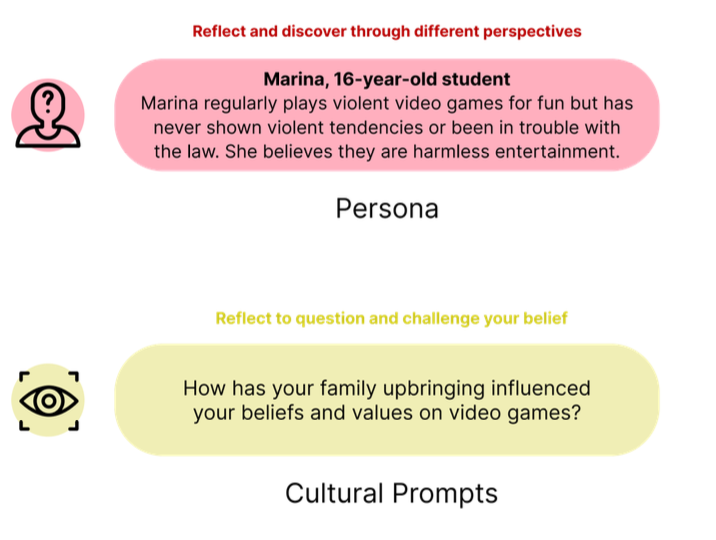
Help Me Reflect: Leveraging Self-Reflection Interface Nudges to Enhance Deliberativeness on Online Deliberation Platforms
Shun Yi Yeo, Gionnieve Lim, Jie Gao, Weiyu Zhang, Simon Tangi Perrault
CHI 2024 ACM CHI Conference on Human Factors in Computing Systems
The deliberative potential of online platforms has been widely examined. However, little is known about how various interface-based reflection nudges impact the quality of deliberation. This paper presents two user studies with 12 and 120 participants, respectively, to investigate the impacts of different reflective nudges on the quality of deliberation. In the first study, we examined five distinct reflective nudges: persona, temporal prompts, analogies and metaphors, cultural prompts and storytelling. Persona, temporal prompts, and storytelling emerged as the preferred nudges for implementation on online deliberation platforms. In the second study, we assess the impacts of these preferred reflectors more thoroughly. Results revealed a significant positive impact of these reflectors on deliberative quality. Specifically, persona promotes a deliberative environment for balanced and opinionated viewpoints while temporal prompts promote more individualised viewpoints. Our findings suggest that the choice of reflectors can significantly influence the dynamics and shape the nature of online discussions.
Help Me Reflect: Leveraging Self-Reflection Interface Nudges to Enhance Deliberativeness on Online Deliberation Platforms
Shun Yi Yeo, Gionnieve Lim, Jie Gao, Weiyu Zhang, Simon Tangi Perrault
CHI 2024 ACM CHI Conference on Human Factors in Computing Systems
The deliberative potential of online platforms has been widely examined. However, little is known about how various interface-based reflection nudges impact the quality of deliberation. This paper presents two user studies with 12 and 120 participants, respectively, to investigate the impacts of different reflective nudges on the quality of deliberation. In the first study, we examined five distinct reflective nudges: persona, temporal prompts, analogies and metaphors, cultural prompts and storytelling. Persona, temporal prompts, and storytelling emerged as the preferred nudges for implementation on online deliberation platforms. In the second study, we assess the impacts of these preferred reflectors more thoroughly. Results revealed a significant positive impact of these reflectors on deliberative quality. Specifically, persona promotes a deliberative environment for balanced and opinionated viewpoints while temporal prompts promote more individualised viewpoints. Our findings suggest that the choice of reflectors can significantly influence the dynamics and shape the nature of online discussions.
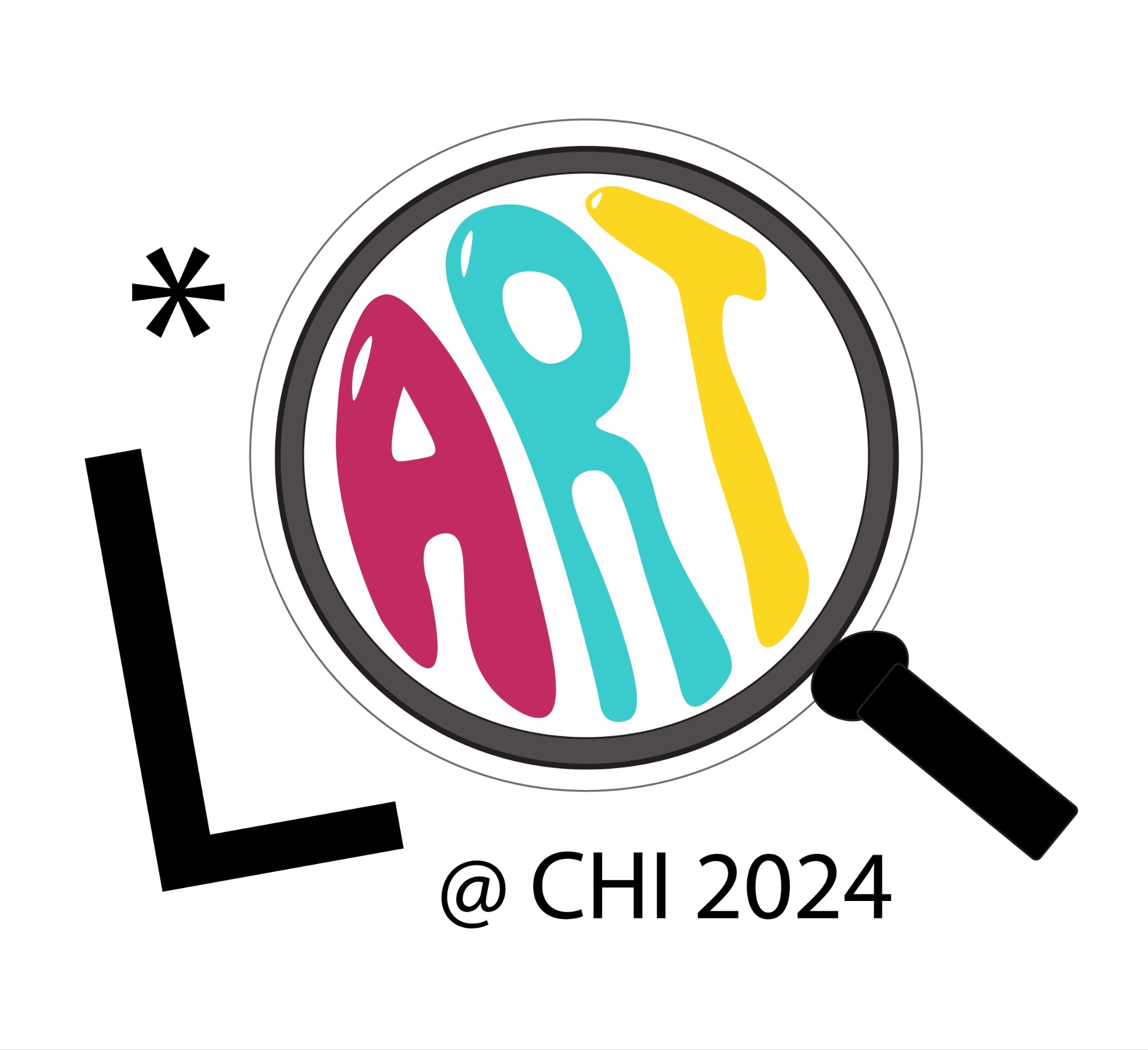
LLMs as Research Tools: Applications and Evaluations in HCI Data Work
Marianne Aubin Le Quéré, Hope Schroeder, Casey Randazzo, Jie Gao, Ziv Epstein, Simon Tangi Perrault, David Mimno, Louise Barkhuus, Hanlin Li
Workshop Proposal ACM CHI Conference on Human Factors in Computing Systems
Large language models (LLMs) stand to reshape traditional methods of working with data. While LLMs unlock new and potentially useful ways of interfacing with data, their use in research processes requires methodological and critical evaluation. In this workshop, we seek to gather a community of HCI researchers interested in navigating the responsible integration of LLMs into data work: data collection, processing, and analysis. We aim to create an understanding of how LLMs are being used to work with data in HCI research, and document the early challenges and concerns that have arisen. Together, we will outline a research agenda on using LLMs as research tools to work with data by defining the open empirical and ethical evaluation questions and thus contribute to setting norms in the community. We believe CHI to be the ideal place to address these questions due to the methodologically diverse researcher attendees, the prevalence of HCI research on human interaction with new computing and data paradigms, and the community’s sense of ethics and care. Insights from this forum can contribute to other research communities grappling with related questions.
LLMs as Research Tools: Applications and Evaluations in HCI Data Work
Marianne Aubin Le Quéré, Hope Schroeder, Casey Randazzo, Jie Gao, Ziv Epstein, Simon Tangi Perrault, David Mimno, Louise Barkhuus, Hanlin Li
Workshop Proposal ACM CHI Conference on Human Factors in Computing Systems
Large language models (LLMs) stand to reshape traditional methods of working with data. While LLMs unlock new and potentially useful ways of interfacing with data, their use in research processes requires methodological and critical evaluation. In this workshop, we seek to gather a community of HCI researchers interested in navigating the responsible integration of LLMs into data work: data collection, processing, and analysis. We aim to create an understanding of how LLMs are being used to work with data in HCI research, and document the early challenges and concerns that have arisen. Together, we will outline a research agenda on using LLMs as research tools to work with data by defining the open empirical and ethical evaluation questions and thus contribute to setting norms in the community. We believe CHI to be the ideal place to address these questions due to the methodologically diverse researcher attendees, the prevalence of HCI research on human interaction with new computing and data paradigms, and the community’s sense of ethics and care. Insights from this forum can contribute to other research communities grappling with related questions.
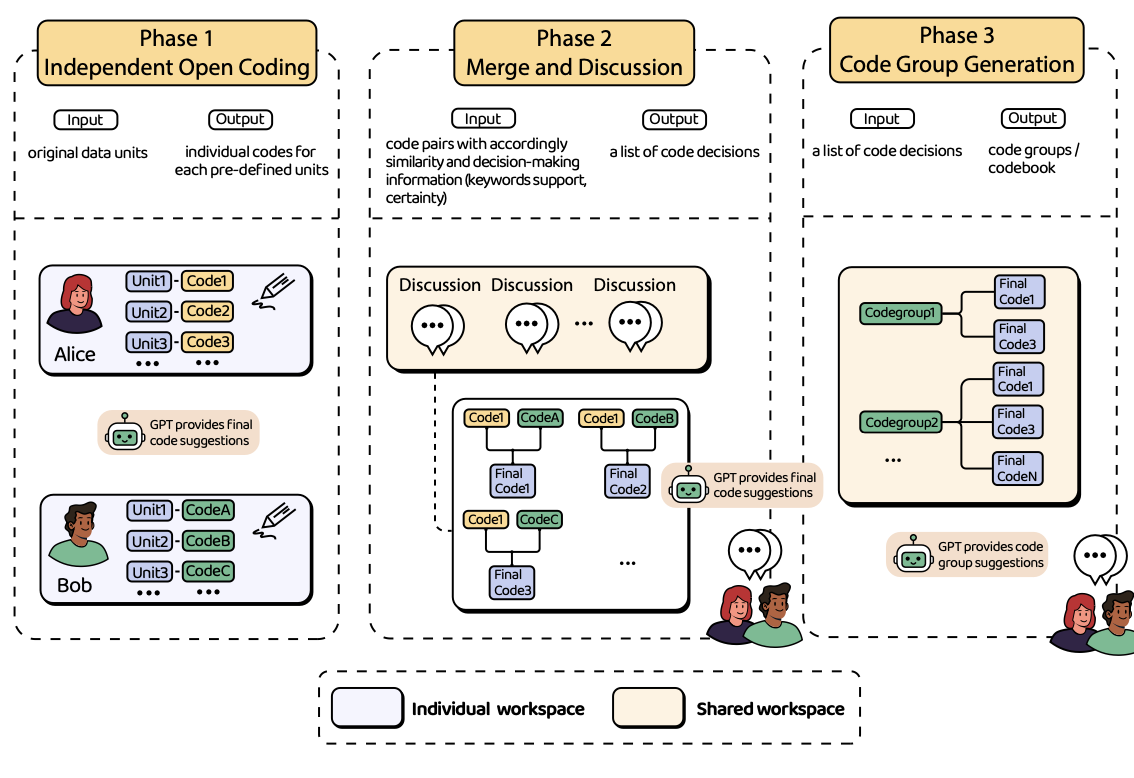
CollabCoder: A Lower-barrier, Rigorous Workflow for Inductive Collaborative Qualitative Analysis with Large Language Models
Jie Gao, Yuchen Guo, Gionnieve Lim, Tianqin Zhang, Zheng Zhang, Toby Jia-Jun Li, Simon Tangi Perrault
CHI 2024 Featured ACM CHI Conference on Human Factors in Computing Systems
Collaborative Qualitative Analysis (CQA) can enhance qualitative analysis rigor and depth by incorporating varied viewpoints. Nevertheless, ensuring a rigorous CQA procedure itself can be both complex and costly. To lower this bar, we take a theoretical perspective to design a one-stop, end-to-end workflow, CollabCoder, that integrates Large Language Models (LLMs) into key inductive CQA stages. In the independent open coding phase, CollabCoder offers AI-generated code suggestions and records decision-making data. During the iterative discussion phase, it promotes mutual understanding by sharing this data within the coding team and using quantitative metrics to identify coding (dis)agreements, aiding in consensus-building. In the codebook development phase, CollabCoder provides primary code group suggestions, lightening the workload of developing a codebook from scratch. A 16-user evaluation confirmed the effectiveness of CollabCoder, demonstrating its advantages over the existing CQA platform. All related materials of CollabCoder, including code and further extensions, will be included in: https://gaojie058.github.io/CollabCoder/.
CollabCoder: A Lower-barrier, Rigorous Workflow for Inductive Collaborative Qualitative Analysis with Large Language Models
Jie Gao, Yuchen Guo, Gionnieve Lim, Tianqin Zhang, Zheng Zhang, Toby Jia-Jun Li, Simon Tangi Perrault
CHI 2024 Featured ACM CHI Conference on Human Factors in Computing Systems
Collaborative Qualitative Analysis (CQA) can enhance qualitative analysis rigor and depth by incorporating varied viewpoints. Nevertheless, ensuring a rigorous CQA procedure itself can be both complex and costly. To lower this bar, we take a theoretical perspective to design a one-stop, end-to-end workflow, CollabCoder, that integrates Large Language Models (LLMs) into key inductive CQA stages. In the independent open coding phase, CollabCoder offers AI-generated code suggestions and records decision-making data. During the iterative discussion phase, it promotes mutual understanding by sharing this data within the coding team and using quantitative metrics to identify coding (dis)agreements, aiding in consensus-building. In the codebook development phase, CollabCoder provides primary code group suggestions, lightening the workload of developing a codebook from scratch. A 16-user evaluation confirmed the effectiveness of CollabCoder, demonstrating its advantages over the existing CQA platform. All related materials of CollabCoder, including code and further extensions, will be included in: https://gaojie058.github.io/CollabCoder/.
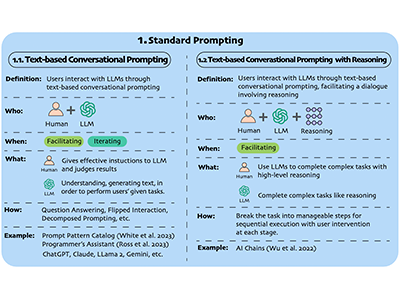
A Taxonomy for Human-LLM Interaction Modes: An Initial Exploration
Jie Gao*, Simret Araya Gebreegziabher*, Kenny Tsu Wei Choo, Toby Jia-Jun Li, Simon Tangi Perrault, Thomas W Malone (* equal contribution)
CHI EA 2024 Featured Extended Abstract of ACM CHI Conference on Human Factors in Computing Systems
With ChatGPT’s release, conversational prompting has become the most popular form of human-LLM interaction. However, its effectiveness is limited for more complex tasks involving reasoning, creativity, and iteration. Through a systematic analysis of HCI papers published since 2021, we identified four key phases in the human-LLM interaction flow—planning, facilitating, iterating, and testing—to precisely understand the dynamics of this process. Additionally, we have developed a taxonomy of four primary interaction modes: Mode 1: Standard Prompting, Mode 2: User Interface, Mode 3: Context-based, and Mode 4: Agent Facilitator. This taxonomy was further enriched using the “5W1H” guideline method, which involved a detailed examination of definitions, participant roles (Who), the phases that happened (When), human objectives and LLM abilities (What), and the mechanics of each interaction mode (How). We anticipate this taxonomy will contribute to the future design and evaluation of human-LLM interaction.
A Taxonomy for Human-LLM Interaction Modes: An Initial Exploration
Jie Gao*, Simret Araya Gebreegziabher*, Kenny Tsu Wei Choo, Toby Jia-Jun Li, Simon Tangi Perrault, Thomas W Malone (* equal contribution)
CHI EA 2024 Featured Extended Abstract of ACM CHI Conference on Human Factors in Computing Systems
With ChatGPT’s release, conversational prompting has become the most popular form of human-LLM interaction. However, its effectiveness is limited for more complex tasks involving reasoning, creativity, and iteration. Through a systematic analysis of HCI papers published since 2021, we identified four key phases in the human-LLM interaction flow—planning, facilitating, iterating, and testing—to precisely understand the dynamics of this process. Additionally, we have developed a taxonomy of four primary interaction modes: Mode 1: Standard Prompting, Mode 2: User Interface, Mode 3: Context-based, and Mode 4: Agent Facilitator. This taxonomy was further enriched using the “5W1H” guideline method, which involved a detailed examination of definitions, participant roles (Who), the phases that happened (When), human objectives and LLM abilities (What), and the mechanics of each interaction mode (How). We anticipate this taxonomy will contribute to the future design and evaluation of human-LLM interaction.
2023
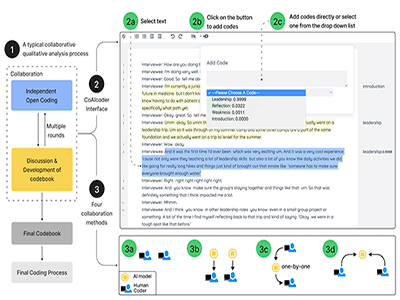
CoAIcoder: Examining the effectiveness of AI-assisted human-to-human collaboration in qualitative analysis
Jie Gao, Kenny Tsu Wei Choo, Junming Cao, Roy Ka-Wei Lee, Simon Perrault
TOCHI 2023 Featured ACM Transactions on Computer-Human Interaction
While AI-assisted individual qualitative analysis has been substantially studied, AI-assisted collaborative qualitative analysis (CQA) – a process that involves multiple researchers working together to interpret data—remains relatively unexplored. After identifying CQA practices and design opportunities through formative interviews, we designed and implemented CoAIcoder, a tool leveraging AI to enhance human-to-human collaboration within CQA through four distinct collaboration methods. With a between-subject design, we evaluated CoAIcoder with 32 pairs of CQA-trained participants across common CQA phases under each collaboration method. Our findings suggest that while using a shared AI model as a mediator among coders could improve CQA efficiency and foster agreement more quickly in the early coding stage, it might affect the final code diversity. We also emphasize the need to consider the independence level when using AI to assist human-to-human collaboration in various CQA scenarios. Lastly, we suggest design implications for future AI-assisted CQA systems.
CoAIcoder: Examining the effectiveness of AI-assisted human-to-human collaboration in qualitative analysis
Jie Gao, Kenny Tsu Wei Choo, Junming Cao, Roy Ka-Wei Lee, Simon Perrault
TOCHI 2023 Featured ACM Transactions on Computer-Human Interaction
While AI-assisted individual qualitative analysis has been substantially studied, AI-assisted collaborative qualitative analysis (CQA) – a process that involves multiple researchers working together to interpret data—remains relatively unexplored. After identifying CQA practices and design opportunities through formative interviews, we designed and implemented CoAIcoder, a tool leveraging AI to enhance human-to-human collaboration within CQA through four distinct collaboration methods. With a between-subject design, we evaluated CoAIcoder with 32 pairs of CQA-trained participants across common CQA phases under each collaboration method. Our findings suggest that while using a shared AI model as a mediator among coders could improve CQA efficiency and foster agreement more quickly in the early coding stage, it might affect the final code diversity. We also emphasize the need to consider the independence level when using AI to assist human-to-human collaboration in various CQA scenarios. Lastly, we suggest design implications for future AI-assisted CQA systems.
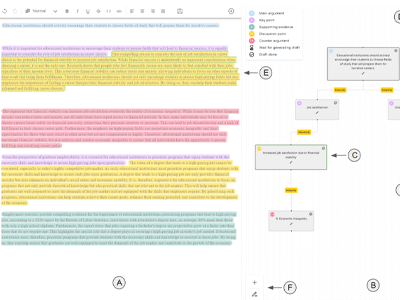
VISAR: A Human-AI Argumentative Writing Assistant with Visual Programming and Rapid Draft Prototyping
Zheng Zhang, Jie Gao, Ranjodh Singh Dhaliwal, Toby Jia-Jun Li
UIST 2023 Annual ACM Symposium on User Interface Software and Technology
In argumentative writing, writers must brainstorm hierarchical writing goals, ensure the persuasiveness of their arguments, and revise and organize their plans through drafting. Recent advances in large language models (LLMs) have made interactive text generation through a chat interface (e.g., ChatGPT) possible. However, this approach often neglects implicit writing context and user intent, lacks support for user control and autonomy, and provides limited assistance for sensemaking and revising writing plans. To address these challenges, we introduce VISAR, an AI-enabled writing assistant system designed to help writers brainstorm and revise hierarchical goals within their writing context, organize argument structures through synchronized text editing and visual programming, and enhance persuasiveness with argumentation spark recommendations. VISAR allows users to explore, experiment with, and validate their writing plans using automatic draft prototyping. A controlled lab study confirmed the usability and effectiveness of VISAR in facilitating the argumentative writing planning process.
VISAR: A Human-AI Argumentative Writing Assistant with Visual Programming and Rapid Draft Prototyping
Zheng Zhang, Jie Gao, Ranjodh Singh Dhaliwal, Toby Jia-Jun Li
UIST 2023 Annual ACM Symposium on User Interface Software and Technology
In argumentative writing, writers must brainstorm hierarchical writing goals, ensure the persuasiveness of their arguments, and revise and organize their plans through drafting. Recent advances in large language models (LLMs) have made interactive text generation through a chat interface (e.g., ChatGPT) possible. However, this approach often neglects implicit writing context and user intent, lacks support for user control and autonomy, and provides limited assistance for sensemaking and revising writing plans. To address these challenges, we introduce VISAR, an AI-enabled writing assistant system designed to help writers brainstorm and revise hierarchical goals within their writing context, organize argument structures through synchronized text editing and visual programming, and enhance persuasiveness with argumentation spark recommendations. VISAR allows users to explore, experiment with, and validate their writing plans using automatic draft prototyping. A controlled lab study confirmed the usability and effectiveness of VISAR in facilitating the argumentative writing planning process.
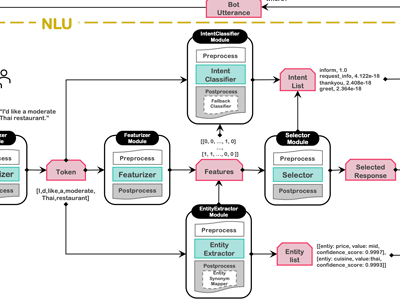
Characterizing the complexity and its impact on testing in ml-enabled systems: A case sutdy on rasa
Junming Cao, Bihuan Chen, Longjie Hu, Jie Gao, Kaifeng Huang, Xuezhi Song, Xin Peng
ICSME 2023 IEEE International Conference on Software Maintenance and Evolution
Machine learning (ML) enabled systems are emerging with recent breakthroughs in ML. A model-centric view is widely taken by the literature to focus only on the analysis of ML models. However, only a small body of work takes a system view that looks at how ML components work with the system and how they affect software engineering for ML-enabled systems. In this paper, we adopt this system view, and conduct a case study on Rasa 3.0, an industrial dialogue system that has been widely adopted by various companies around the world. Our goal is to characterize the complexity of such a large-scale ML-enabled system and to understand the impact of the complexity on testing. Our study reveals practical implications for software engineering for ML-enabled systems.
Characterizing the complexity and its impact on testing in ml-enabled systems: A case sutdy on rasa
Junming Cao, Bihuan Chen, Longjie Hu, Jie Gao, Kaifeng Huang, Xuezhi Song, Xin Peng
ICSME 2023 IEEE International Conference on Software Maintenance and Evolution
Machine learning (ML) enabled systems are emerging with recent breakthroughs in ML. A model-centric view is widely taken by the literature to focus only on the analysis of ML models. However, only a small body of work takes a system view that looks at how ML components work with the system and how they affect software engineering for ML-enabled systems. In this paper, we adopt this system view, and conduct a case study on Rasa 3.0, an industrial dialogue system that has been widely adopted by various companies around the world. Our goal is to characterize the complexity of such a large-scale ML-enabled system and to understand the impact of the complexity on testing. Our study reveals practical implications for software engineering for ML-enabled systems.
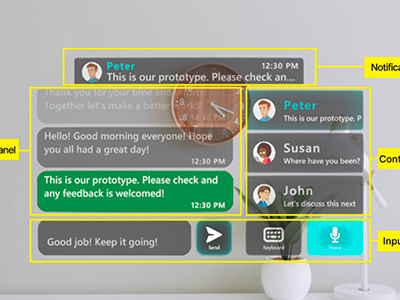
GlassMessaging: Towards Ubiquitous Messaging Using OHMDs
Nuwan Janaka, Jie Gao, Lin Zhu, Shengdong Zhao, Lan Lyu, Peisen Xu, Maximilian Nabokow, Silang Wang, Yanch Ong
IMWUT 2023 Proceedings of the ACM on Interactive, Mobile, Wearable and Ubiquitous Technologies
Communicating with others while engaging in simple daily activities is both common and natural for people. However, due to the hands- and eyes-busy nature of existing digital messaging applications, it is challenging to message someone while performing simple daily activities. We present GlassMessaging, a messaging application on Optical See-Through Head-Mounted Displays (OHMDs), to support messaging with voice and manual inputs in hands- and eyes-busy scenarios. GlassMessaging is iteratively developed through a formative study identifying current messaging behaviors and challenges in common multitasking with messaging scenarios. We then evaluated this application against the mobile phone platform on varying texting complexities in eating and walking scenarios. Our results showed that, compared to phone-based messaging, GlassMessaging increased messaging opportunities during multitasking due to its hands-free, wearable nature, and multimodal input capabilities. The affordance of GlassMessaging also allows users easier access to voice input than the phone, which thus reduces the response time by 33.1% and increases the texting speed by 40.3%, with a cost in texting accuracy of 2.5%, particularly when the texting complexity increases. Lastly, we discuss trade-offs and insights to lay a foundation for future OHMD-based messaging applications.
GlassMessaging: Towards Ubiquitous Messaging Using OHMDs
Nuwan Janaka, Jie Gao, Lin Zhu, Shengdong Zhao, Lan Lyu, Peisen Xu, Maximilian Nabokow, Silang Wang, Yanch Ong
IMWUT 2023 Proceedings of the ACM on Interactive, Mobile, Wearable and Ubiquitous Technologies
Communicating with others while engaging in simple daily activities is both common and natural for people. However, due to the hands- and eyes-busy nature of existing digital messaging applications, it is challenging to message someone while performing simple daily activities. We present GlassMessaging, a messaging application on Optical See-Through Head-Mounted Displays (OHMDs), to support messaging with voice and manual inputs in hands- and eyes-busy scenarios. GlassMessaging is iteratively developed through a formative study identifying current messaging behaviors and challenges in common multitasking with messaging scenarios. We then evaluated this application against the mobile phone platform on varying texting complexities in eating and walking scenarios. Our results showed that, compared to phone-based messaging, GlassMessaging increased messaging opportunities during multitasking due to its hands-free, wearable nature, and multimodal input capabilities. The affordance of GlassMessaging also allows users easier access to voice input than the phone, which thus reduces the response time by 33.1% and increases the texting speed by 40.3%, with a cost in texting accuracy of 2.5%, particularly when the texting complexity increases. Lastly, we discuss trade-offs and insights to lay a foundation for future OHMD-based messaging applications.
2022
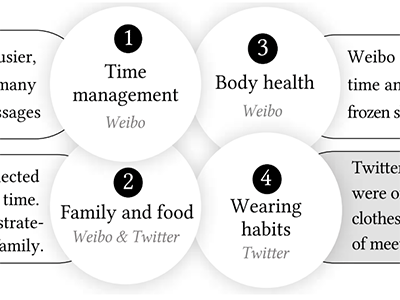
Differences of Challenges of Working from Home (WFH) between Weibo and Twitter Users during COVID-19
Jie Gao, Xiayin Ying, Junming Cao, Yifan Yang, Pin Sym Foong, Simon Perrault
CHI EA 2022 ACM CHI Conference on Human Factors in Computing Systems
People face lots of challenges when working from home (WFH). In this paper, we used both LDA (Latent Dirichlet Allocation) topic modeling and qualitative analysis to analyse WFH related posts on Weibo (N=1093) and Twitter (N=907) during COVID-19. We highlighted unique differences of WFH challenges between two platforms, including long work time, family and food commitment and health concerns on Weibo; casual wearing habits on Twitter. We then provided possible guidelines from a cross-cultural perspective on how to improve the WFH experience based on these differences.
Differences of Challenges of Working from Home (WFH) between Weibo and Twitter Users during COVID-19
Jie Gao, Xiayin Ying, Junming Cao, Yifan Yang, Pin Sym Foong, Simon Perrault
CHI EA 2022 ACM CHI Conference on Human Factors in Computing Systems
People face lots of challenges when working from home (WFH). In this paper, we used both LDA (Latent Dirichlet Allocation) topic modeling and qualitative analysis to analyse WFH related posts on Weibo (N=1093) and Twitter (N=907) during COVID-19. We highlighted unique differences of WFH challenges between two platforms, including long work time, family and food commitment and health concerns on Weibo; casual wearing habits on Twitter. We then provided possible guidelines from a cross-cultural perspective on how to improve the WFH experience based on these differences.